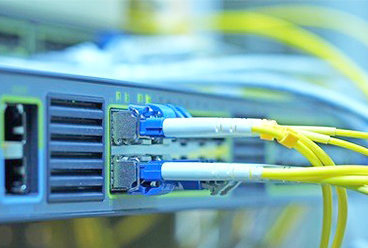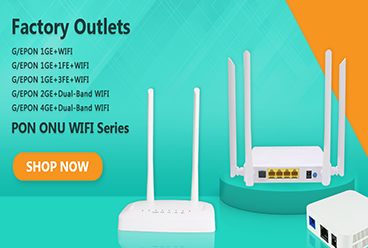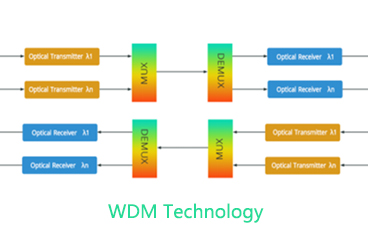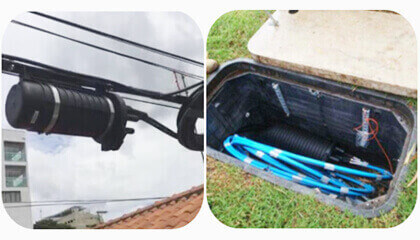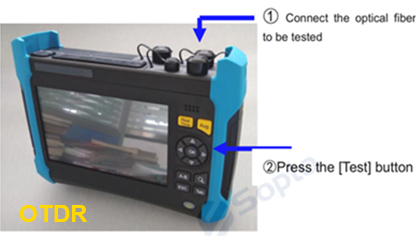Characteristics of optical fibers
The structure of the optical fiber is drawn from a prefabricated silica optical fiber rod, and the outer diameter of the multi-mode optical fiber and single-mode optical fiber for communication is 125 μm.
The fiber body is divided into two regions,the core and the cladding layer. The core diameter of single-mode fiber is 8~10μm, and the core diameter of multi-mode fiber has two standard specifications, the core diameter is 62.5μm (American standard) and 50μm (European standard).
The interface fiber specification has the following description,62.5μm/125μm multimode fiber, where 62.5μm refers to the core diameter of the fiber, and 125μm refers to the outer diameter of the fiber.
Single-mode fibers use light wavelengths of 1310 nm or 1550 nm. The wavelength of light used in multimode fibers is mostly 850 nm.
What is the difference between multimode and singlemode fiber?
Multimode, Fibers that can propagate hundreds to thousands of modes are called multimode (MM) fibers. However, the intermodal dispersion is large and increases with the increase of the transmission distance. The transmission distance of multimode fiber is also related to its transmission rate, core diameter and mode bandwidth. According to the radial distribution of refractive index in the core and cladding, it can be divided into step multimode fiber and graded multimode fiber. Almost all multimode fibers are 50/125μm or 62.5/125μm in size, and the bandwidth (the amount of information transmitted by the fiber) is typically 200MHz to 2GHz. Multimode optical transceivers can transmit up to 5 kilometers through multimode optical fibers. Light-emitting diodes or lasers are used as light sources.
Single-mode,Fibers that can only propagate one mode are called single-mode fibers. Standard single-mode (SM) fiber has a refractive index profile similar to that of step-type fiber, except that the core diameter is much smaller than that of multimode fiber. Single-mode fiber is 9-10/125 μm in size and has unlimited bandwidth and lower loss than multimode fiber. The single-mode optical transceiver is mostly used for long-distance transmission, sometimes reaching 150 to 200 kilometers. LDs or LEDs with narrow spectral lines are used as light sources.
Single-mode fiber and multi-mode fiber can be distinguished by color. Single-mode fiber optic patch cords are generally indicated in yellow, connectors and protective sleeves are blue, and the transmission distance is long. Multi-mode fibers are generally indicated in orange, and some are indicated in gray. The connector and protective cover are beige or black, and the transmission distance shorter.
Fiber Patch Cord Interface
Fiber patch cord connectors are a problem that users must consider when purchasing fiber patch cords. Understanding the meaning of various fiber patch cord connectors can help users find the products they want faster.
FC type fiber patch cord
The external reinforcement method is a metal sleeve, and the fastening method is a turnbuckle. The FC connector is generally used in telecommunication networks. There is a nut screwed onto the adapter. The advantage is that it is reliable and dust-proof. The disadvantage is that the installation time is slightly longer. Generally used on the ODF side (the most used on the patch panel, and also mostly used for optical transceivers)
SC type fiber patch cord
The connector for connecting the GBIC optical module has a rectangular shell, and the fastening method is a plug-and-pull type, which does not need to be rotated. The SC connector is directly plugged and unplugged, which is very convenient to use, but the disadvantage is that it is easy to fall out (the most used on routers and switches)
ST type fiber patch cord
After the ST head is inserted, it is fixed by a bayonet half-circle and is fixed. (For 10Base-F connections, the connectors are usually ST type.
LC type fiber patch cord
A connector for connecting SFP modules, constructed with an easy-to-use modular jack (RJ) latch mechanism. (SFP optical module default LC interface)
MT-RJ type fiber patch cord
A square fiber optic connector with integrated transceiver, one dual-fiber transceiver is integrated. MTRJ type fiber optic patch cord consists of two high-precision plastic molded connectors and fiber optic cables. The outer parts of the connector are precision plastic parts, including a push-pull plug-in clamping mechanism. Suitable for indoor applications in telecommunication and data network systems.
Optical Fiber Module Package Type
GBIC (Gigabit Interface Converter) optical module is the first optical module with standardized package interface. It adopts SC interface, which is hot-swappable and can convert gigabit electrical signals into optical signals. It occupied the mainstream market in the 1990s.
SFP (Small Factor Pluggable) optical module is a small pluggable optical module, its volume is twice as small as that of GBIC, more than twice the number of ports are configured on the same size panel, and LC-type optical fiber interfaces are mostly used.
XFP (10 Gigabit Small Form-factor Pluggable) optical module, X represents 10 in Roman numerals, the transmission rate is 9.953Gbps ~ 10.3Gbps, dual LC, hot pluggable, including digital diagnostic function.
SFP+ (10 Gigabit Small Form Factor Pluggable) optical module has the same shape as SFP and realizes 10G signal transmission. SFP+ moves signal modulation functions, serializer/deserializer, MAC, clock and data recovery (CDR), and electronic dispersion compensation (EDC) functions from the module to the motherboard card, enabling high speed, miniaturization, and low cost.
SFP28 (Small Form-factor Pluggable 28) optical module is based on SFP+ package mode, with a transmission rate of 25Gbps, suitable for a single 25GE access port, low power consumption, high port density, which can save network deployment costs, and is widely used in 25G Ethernet network and 100G Ethernet.
QSFP (Quad Small Form-factor Pluggable) optical module is a four-channel small form-factor pluggable optical module. It has four independent full-duplex transceiver channels, replacing single-channel SFP with multi-channel parallel high-density optical modules, while the volume of QSFP is only 30% larger than standard SFP modules. This 4-lane pluggable interface has a transfer rate of 4x10Gbps.
The C in the CFP (Centum Form-factor Pluggable) optical module represents 100, which is mainly aimed at applications of 100G and above rates. The CFP package mode mainly includes CFP/CFP2/CFP4/CFP8. The number after CFP represents the replacement, the size tighter, higher rate.
The size of the CXP (12*Small Form-factor Pluggable) optical module is slightly larger than that of the XFP optical module. C stands for 100G, with 12 built-in transmission channels, each channel runs at a speed of 10Gb/s, and the maximum rate can reach 120G. It is mainly used for Meets the needs of high densities in data centers, typically used with parallel multimode fiber ribbons for distances up to 100 meters.
The packaging method of QSFP28 (Quad Small Form-factor Pluggable 28) optical module is the same as that of QSFP+ optical module, and both use 4 Fibre Channels to transmit data. The difference is that the transmission rate of each Fibre Channel of 100G QSFP28 optical module can reach up to 28Gbps , mainly used for 100G transmission applications.
Tags:optical fiber, fiber patch cord,optical module, and optical fiber connector,fiber
— END —




